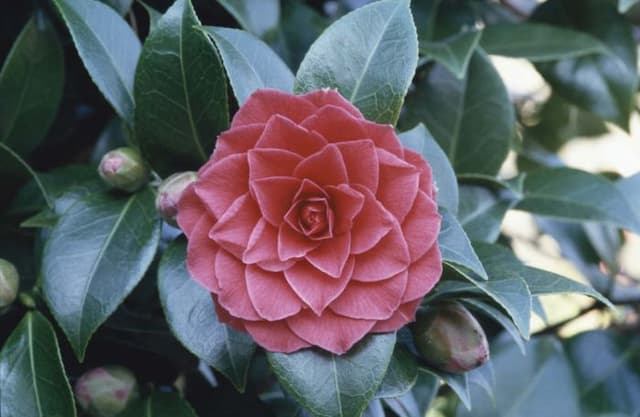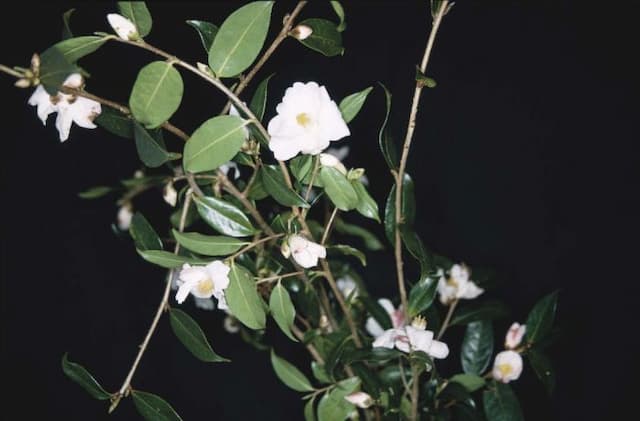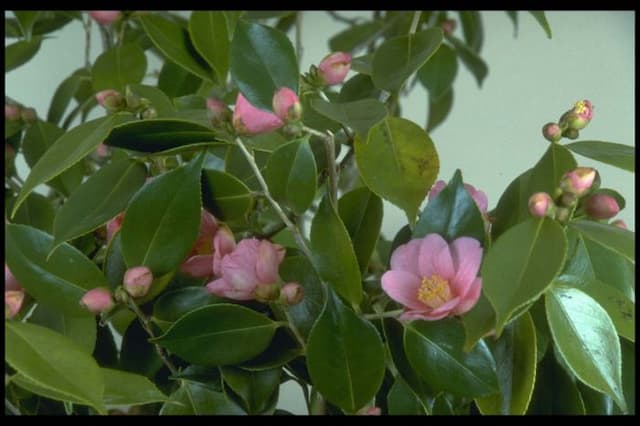Camellia Camellia japonica 'Nuccio's Cameo'

ABOUT
Camellia japonica 'Nuccio's Cameo' is a captivating plant known for its outstanding ornamental flowers. The blossoms are a delightful, peony-like double form, showcasing layers of exquisitely arranged petals. These petals present a soft shade of pink, often described as coral or salmon-pink, that can add a gentle yet colorful touch to any garden setting. The edges of the petals may exhibit a slightly deeper pink, creating a subtle two-tone effect that enhances the flower's visual appeal. Each flower appears glossy and has a waxy texture, contributing to the plant's overall luster. Amidst the layers of petals, the flowers' centers are comprised of elegantly arranged reproductive parts that may be partially hidden by the prominent petals. The glossy green leaves of 'Nuccio's Cameo' provide a lush backdrop to the flowers, with a leathery feel and an elongated oval shape that tapers to a point. The leaves showcase distinct veining, and their margins are finely serrated, lending a touch of texture to the plant's foliage. The camellia blooms primarily during the late winter to early spring months. Its flowers emerge against the glossy evergreen foliage and can be a source of vibrant color during the cooler parts of the year when fewer plants are in bloom. The combination of its striking blooms, glossy green leaves, and the plant's overall elegant shape make 'Nuccio's Cameo' a cherished choice for gardeners seeking to add a classic yet robust floral display to their landscape.
About this plant
 Names
NamesFamily
Theaceae
Synonyms
Japanese Camellia, Camellia
Common names
Camellia japonica 'Nuccio's Cameo'.
 Toxicity
ToxicityTo humans
Camellia japonica, commonly known as Japanese camellia, is not considered toxic to humans. Ingesting any part of this plant typically does not result in poisoning or adverse symptoms.
To pets
Japanese camellia is generally not considered toxic to pets. Ingesting parts of this plant is not expected to cause poisoning or produce harmful symptoms in animals like cats and dogs.
 Characteristics
CharacteristicsLife cycle
Perennials
Foliage type
Evergreen
Color of leaves
Dark green
Flower color
Pink
Height
6-8 feet (1.8-2.4 meters)
Spread
5-7 feet (1.5-2.1 meters)
Plant type
Shrub
Hardiness zones
7-9
Native area
Japan
Benefits
 General Benefits
General Benefits- Ornamental Appeal: Offers vibrant, peony-like pink flowers that enhance the beauty of gardens and landscapes.
- Year-Round Interest: Evergreen foliage provides a backdrop of glossy green leaves throughout the year.
- Shade Tolerance: Can thrive in partial shade, making it versatile for different garden spots.
- Drought Resistance: Once established, it exhibits a degree of drought tolerance, reducing the need for frequent watering.
- Cold Hardy: Resilient in colder climates, suitable for a range of USDA zones.
- Low Maintenance: Requires minimal pruning and care once established.
- Long Blooming Period: The flowers bloom over a long season, typically from winter to spring.
- Pollinator Friendly: Attracts bees and other pollinators, supporting local ecosystems.
- Landscape Versatility: Can be used in a variety of landscaping designs, including hedges, specimen plants, or container gardening.
- Soil Adaptability: Adaptable to a range of soil types, though prefers well-drained, acidic soil.
 Medical Properties
Medical PropertiesThis plant is not used for medical purposes.
 Air-purifying Qualities
Air-purifying QualitiesThis plant is not specifically known for air purifying qualities.
 Other Uses
Other Uses- Textile Dye: The petals of Camellia japonica can be used to create a natural dye for fabrics, providing a range of pink to red hues.
- Photography: The distinct, vibrant flowers are often used in photography, providing a beautiful and natural contrast to otherwise muted compositions.
- Art Supplies: Petals and leaves can be pressed and incorporated into papermaking or used as natural adornments in mixed media art projects.
- Decorative Ice Cubes: Small flowers or petals can be frozen into ice cubes to add an elegant touch to beverages for special occasions.
- Culinary Garnish: Though not widely recognized as edible, the petals, once properly cleaned, can be used to decorate dishes and desserts.
- Wedding Confetti: Dried petals of Camellia japonica can serve as a biodegradable confetti option for eco-friendly celebrations.
- Crafting: The sturdy leaves and petals can be used in crafting, from creating bookmarks to embellishing homemade cards or gift wrap.
- Botanical Illustration: Camellia japonica’s complexity and elegance make it a favoured subject for botanical illustrators and in educational materials about flora.
- Perfume Industry: While not a common ingredient, the scent of Camellia japonica flowers has been used occasionally in perfumery to add floral notes to fragrances.
- Religious Ceremonies: In some cultures, the flowers of Camellia japonica may play a role in religious ceremonies as offerings or decorations.
Interesting Facts
 Feng Shui
Feng ShuiThe Camellia is not used in Feng Shui practice.
 Zodiac Sign Compitability
Zodiac Sign CompitabilityThe Camellia is not used in astrology practice.
 Plant Symbolism
Plant Symbolism- Admiration: The camellia represents admiration and is often given as a gift to express one's esteem or respect for another.
- Perfection: Its beautiful and seemingly flawless form can symbolize the ideal of perfection in various cultures.
- Longevity: Camellias have a long blooming season and are evergreen, which conveys wishes for a long and prosperous life.
- Love: In some cultures, camellias represent love and affection, with different colors conveying different messages, such as red for deep desire and pink for longing.
- Affection: The camellia bloom holds the meaning of deep affection and is often used to show someone that they are missed or cherished.
 Water
WaterThe Camellia japonica, commonly known as the Camellia, requires thorough watering to keep the soil consistently moist but not waterlogged. It's important to water the plant when the top inch of soil feels dry to the touch, which may be about once a week, depending on climate conditions. However, during the growing season, increase watering frequency to maintain the required moisture level, and reduce it in the winter when the plant is not actively growing. A good practice is to provide the Camellia with approximately one to one and a half gallons of water every 7 to 10 days, adjusting as necessary for weather variations. Ensure that the pot has good drainage to prevent root rot.
 Light
LightCamellias thrive in partial shade with some protection from the intense afternoon sun. They do best in a spot that receives morning light and partial afternoon shade. Avoid exposing the Camellia to full, direct sunlight during the hottest part of the day as this can lead to scorching of the leaves.
 Temperature
TemperatureCamellia japonica prefers temperatures ranging from 40 to 85 degrees Fahrenheit. It is hardy to a minimum temperature of around 20 degrees Fahrenheit, but frost can damage the buds and flowers, so proper protection or placement is essential during colder months. The ideal growing temperature for this plant is between 60 to 70 degrees Fahrenheit during the day and slightly cooler at night.
 Pruning
PruningPrune Camellias to maintain shape and promote bushier growth, remove any dead or crossing branches, and encourage next year's blooms. The best time to prune is immediately after the flowers have finished blooming in spring, as Camellias set their flower buds for next year in summer and fall. Pruning can be done annually, and selective thinning helps to improve air circulation throughout the plant.
 Cleaning
CleaningAs needed
 Soil
SoilThe best soil mix for Camellia japonica 'Nuccio's Cameo', commonly known as the Camellia, should be well-draining and slightly acidic with a pH between 5.5 and 6.5. An ideal soil recipe would be a mix of 2 parts peat moss to 1 part perlite or pine bark. This composition ensures adequate moisture retention while providing good aeration and drainage.
 Repotting
RepottingCamellias generally require repotting every 2-3 years. For Camellia japonica 'Nuccio's Cameo', it's best to repot in the late winter or early spring before new growth begins. This schedule helps minimize stress on the plant and encourages healthy development in the upcoming growing season.
 Humidity & Misting
Humidity & MistingCamellia japonica 'Nuccio's Cameo' thrives in moderate to high humidity levels, ideally between 40-60%. Protecting the plant from dry air, especially during winter when indoor heating can reduce indoor humidity, is crucial for its wellbeing.
 Suitable locations
Suitable locationsIndoor
Provide bright, indirect light and ensure high humidity.
Outdoor
Plant in partial shade, shelter from cold winds, maintain moist soil.
Hardiness zone
7-9 USDA
 Life cycle
Life cycleCamellia japonica 'Nuccio's Cameo', commonly known as the Japanese Camellia, starts its life cycle when a seed germinates, usually in the spring or summer, leading to the development of a seedling. As the seedling grows, it develops into a young plant with characteristic glossy green leaves and begins to establish a root system. Over several years, the Japanese Camellia matures into a flowering shrub, with the first blooms typically appearing in the winter to spring. The plant reaches full maturity and continues to produce distinctive, formal double pink flowers year after year, usually peaking in winter. During its mature stage, the Japanese Camellia may be pruned to maintain its shape and encourage fuller blooms. Eventually, after many years, usually several decades, the plant will reach the end of its life cycle and die, but it can propagate through seeds, cuttings, or layering, thus continuing the cycle.
 Propogation
PropogationPropogation time
Spring-Early Summer
The Camellia japonica 'Nuccio's Cameo', commonly known as the Camellia, is most effectively propagated through semi-hardwood cuttings. This method is commonly done during the late summer to early fall when the new growth begins to harden slightly. To propagate by this method, choose a healthy stem that has begun to mature but is not yet fully woody. Cut a 4 to 6-inch (about 10 to 15 centimeters) length from the stem, ensuring it includes at least two nodes. Remove the leaves from the lower half of the cutting and dip the cut end in rooting hormone to encourage root development. The cutting should then be placed in a well-draining potting mix, ensuring at least one node is beneath the soil surface. Keep the potting medium moist but not waterlogged, and maintain a high humidity environment. In time, the cutting will develop roots and can eventually be transplanted into the garden or a larger container.









